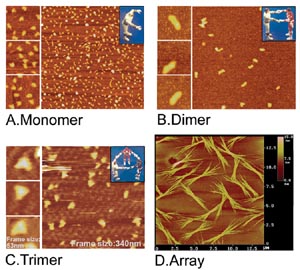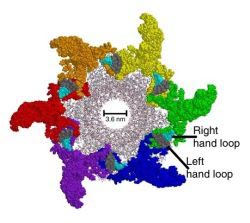Home > News > Old Company Press Releases > Purdue News
RNA Could Form Building Blocks For Nanomachines
West Lafayette, Ind. August 11th, 2004
Microscopic scaffolding to house the tiny
components of nanotech devices could be built from RNA, the same
substance that shuttles messages around a cell's nucleus, reports a
Purdue University research group.
By encouraging ribonucleic acid (RNA) molecules to self-assemble into
3-D shapes resembling spirals, triangles, rods and hairpins, the group
has found what could be a method of constructing lattices on which to
build complex microscopic machines. From such RNA blocks, the group has
already constructed arrays that are several micrometers in diameter -
still microscopically small, but exciting because manipulating
controllable structures of this size from nanoparticles is one of
nanotechnology's main goals.
"Our work shows that we can control the construction of
three-dimensional arrays made from RNA blocks of different shapes and
sizes," said Peixuan Guo, who is a professor of molecular virology in
Purdue's School of Veterinary Medicine. "With further research, RNA
could form the superstructures for tomorrow's nanomachines."
The paper, which Guo co-authored with Dan Shu, Wulf-Dieter Moll,
Zhaoxiang Deng and Chengde Mao, all of Purdue, appears in the August
issue of the journal Nano Letters.
Nanotechnologists, like those in Guo's group, hope to build microscopic
devices with sizes that are best measured in nanometers - or billionths
of a meter. Because nature routinely creates nano-sized structures for
living things, many researchers are turning to biology for their
inspiration and construction tools.
"Biology builds beautiful nanoscale structures, and we'd like to borrow
some of them for nanotechnology," Guo said. "The trouble is, when we're
working with such tiny blocks, we are short of tiny steam shovels to
push them around. So we need to design and construct materials that can
assemble themselves."
Organisms are built in large part of three main types of building
blocks: proteins, DNA and RNA. Of the three, perhaps least investigated
and understood is RNA, a molecular cousin to the DNA that stores
genetic blueprints within our cells' nuclei. RNA typically receives
less attention than other substances from many nanotechnologists, but
Guo said the molecule has distinct advantages.
"RNA combines the advantages of both DNA and proteins and puts them at
the nanotechnologist's disposal," Guo said. "It forms versatile
structures that are also easy to produce, manipulate and engineer."
Since his discovery of a novel RNA that plays a vital role in a
microscopic "motor" used by the bacterial virus phi29 (see related
story), Guo has continued to study the structure of this RNA molecule
for years. It formed the "pistons" of a tiny motor his lab created
several years ago, and members of the team collaborated previously to
build dimers and trimers - molecules formed from two and three RNA
strands, respectively. Guo said the methods the team used in the past
made their recent, more comprehensive construction work possible.
"By designing sets of matching RNA molecules, we can program RNA
building blocks to bind to each other in precisely defined ways," he
said. "We can get them to form the nano-shapes we want."
From the small shapes that RNA can form - hoops, triangles and so forth
- larger, more elaborate structures can in turn be constructed, such as
rods gathered into spindly, many-pronged bundles. These structures
could theoretically form the scaffolding on which other components,
such as nano-sized transistors, wires or sensors, could be mounted.
"Because these RNA structures can be engineered to put themselves
together, they could be useful to industrial and medical specialists,
who will appreciate their ease of engineering and handling," said
Dieter Moll, a postdoctoral researcher in Guo's lab. "Self-assembly
means cost-effective."
Moll, while bullish on RNA's prospects, cautioned that there was more
work to be done before nanoscale models could be built at will.
"One of our main concerns right now is that, over time, RNA tends to
degrade biologically," he said. "We are already working on ways to make
it more resistant to degradation so that it can form long-lasting
structures."
Guo said that though applications might be many years away, it would be
most productive to take the long-term approach.
"We have not built actual scaffolds yet, just 3-D arrays," he said.
"But we have built them from engineered biological molecules, and that
could help us bridge the gap between the living and the nonliving
world. If nanotech devices can eventually be built from both organic
and inorganic materials, it would ease their use in both medical and
industrial settings, which could multiply their usefulness
considerably."
This research was sponsored in part by the National Science Foundation,
the National Institutes of Health and the Department of Defense. Moll's
postdoctoral research is funded by the Austrian Science Fund's Erwin
Schroedinger Fellowship.
Guo is affiliated with Purdue's Cancer Center and Birck Nanotechnology
Center. The Cancer Center, one of just eight National Cancer
Institute-designated basic research facilities in the United States,
attempts to help cancer patients by identifying new molecular targets
and designing future agents and drugs for effectively detecting and
treating cancer.
The Birck Nanotechnology Center is located in Purdue's new Discovery
Park, located on the southwestern edge of campus. Programs include
undergraduate teaching, graduate research and technology transfer
initiatives with industry partners. Scientists in biology, chemistry,
physics and several engineering disciplines participate in the research.
Writer:
Chad Boutin, (765) 494-2081, cboutin@Purdue.eduSources:
Sources: Peixuan Guo, (765) 494-7561, guop@Purdue.edu and Wulf-Dieter Moll, (765) 494-0506, wmoll@Purdue.eduRelated Web sites:
Releases on previous research from Guo's lab: RNA 'motor' transports DNA in virusPurdue researchers connect life's blueprints with its energy source
Birck Nanotechnology Center
Purdue Cancer Center
For further information, please contact:
Purdue University News Service
400 Centennial Mall Drive Room 324
West Lafayette, IN 47906-2016
Purduenews@Purdue.edu
Office (765) 494-2096
Fax (765) 494-0401
Copyright Purdue University. Reprinted with premission.
If you have a comment, please
us.
|
|
||
|
|
||
| The latest news from around the world, FREE | ||
|
|
||
|
|
||
| Premium Products | ||
|
|
||
|
Only the news you want to read!
Learn More |
||
|
|
||
|
Full-service, expert consulting
Learn More |
||
|
|
||

